Centuries ago, there was a prevailing belief that the Earth occupied the center of the universe, with all other celestial bodies orbiting around it. In today’s world, this notion has been widely discredited, and it is now widely accepted that the Earth revolves around the central star. The Solar System is comprised of all the natural objects in space that orbit the Sun, including the Earth and the other planets.
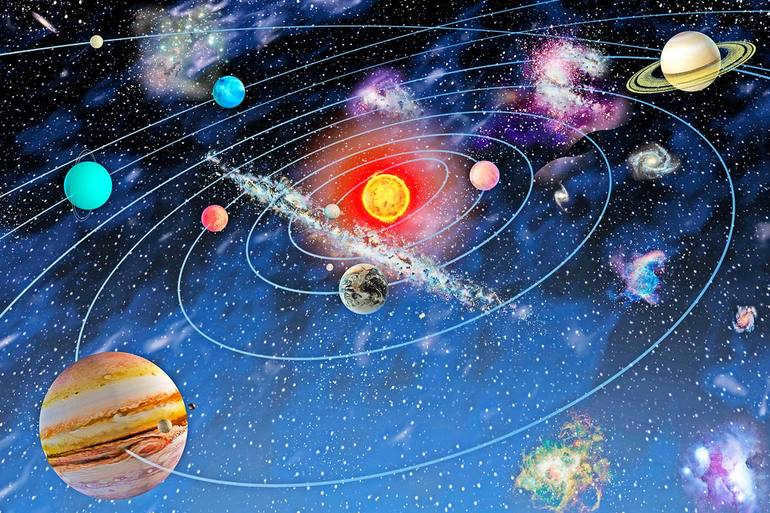
Composition and Position in the Universe
The majority of the mass in the entire solar system (99.86%) is concentrated in the central star, while the remaining mass is distributed among the eight planets and other celestial objects. The mass of the Sun is widely accepted as a standard unit of measurement in astronomy and is represented as – M☉.
All the planets orbit the Sun in circular paths within the ecliptic plane and are categorized into two main groups:
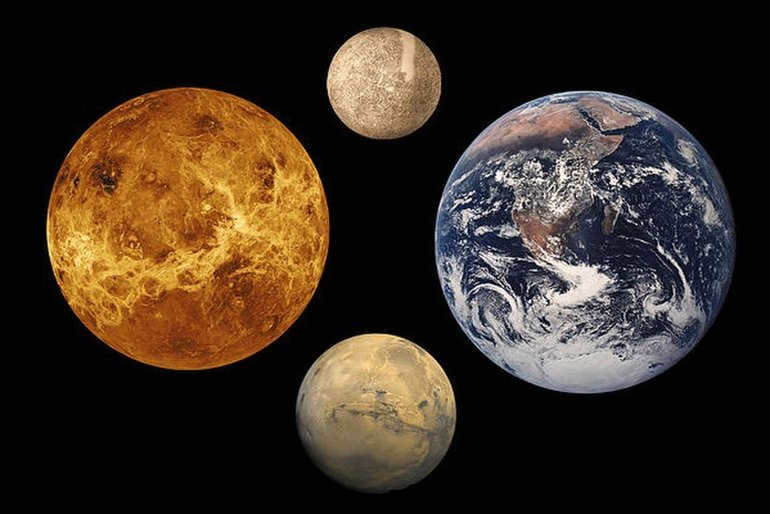
- There are four planets in the Earth group: Mercury, Venus, Earth, and Mars. These planets are characterized by their relatively small size, solid surface, and chemical composition, which is mainly made up of metals and minerals.
- The gas giants in our solar system are located at a significant distance from the Sun. This group includes Jupiter, Saturn, Uranus, and Neptune. These giants have a massive size and are primarily composed of hydrogen and helium. Unlike the other gas giants, Uranus and Neptune are classified as “ice giants” because they contain frozen ammonia and carbon monoxide.
All planets, except for Mercury and Venus, have a varying number of natural satellites. Earth has one satellite, while Jupiter has the most with a total of 79 satellites.
Aside from the primary planets, there are numerous smaller entities scattered throughout the solar system, primarily found in two specific regions:
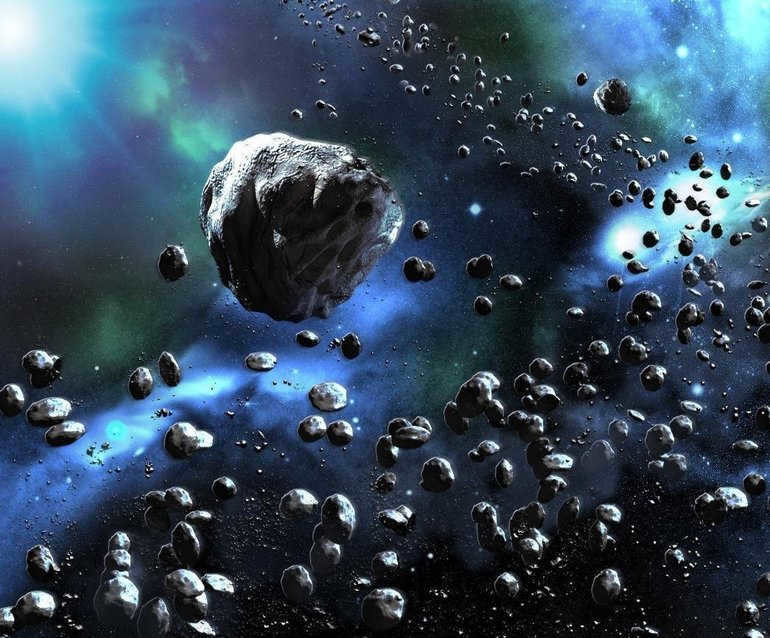
- Situated between the orbits of Mars and Jupiter, the asteroid belt shares the same chemical composition as the Earth-group planets. The largest object within this belt is the dwarf planet Ceres, measuring 950 km in diameter and making up one-third of the total mass of all asteroids.
- Transneptunian objects are located over 4.5 billion kilometers away from the Sun, consisting mainly of frozen gases and water.
Additionally, it is important to consider the vast accumulation of other celestial bodies under the gravitational influence of the central star. A crucial component of the system is the solar wind, consisting of plasma streams emanating from the Sun.
The Solar planetary system is situated in the Orion arm of the Milky Way spiral galaxy, approximately 27 thousand light years away from its central region. The star orbits around the galactic nucleus once every 225-250 million years.
A Celestial Body Known as the Sun
The Sun serves as the core of the solar system and the earthly realm. Its sunrise and sunset are witnessed by people on a daily basis. It is the most recognizable and unchanging entity in the entire Universe. It warms the oceans, shapes the climate, and supplies energy to plants, which in turn provide food and oxygen. The existence of human beings is sustained by the Sun. Despite its magnificent splendor, this source of energy is remarkably treacherous. The entire civilization is reliant on the caprices of this celestial entity.
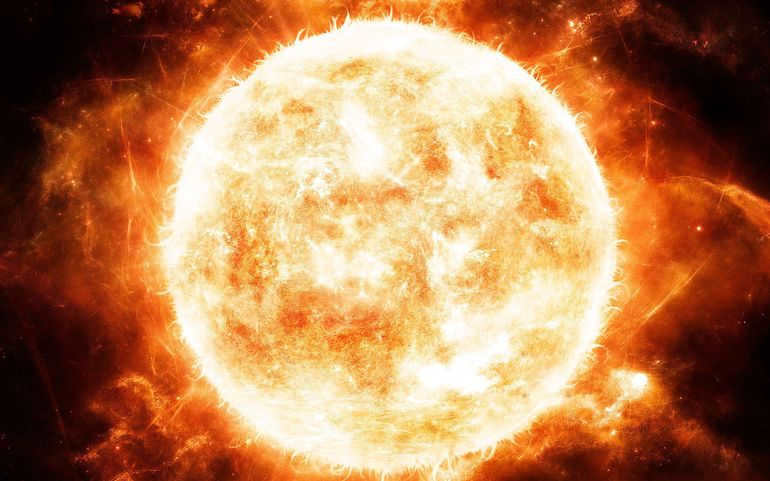
The Sun has the following main characteristics:
- The diameter of the Sun is 1,390,000 kilometers;
- The mass of the Sun is 1.9885×10^30 kg;
- The average distance from the Sun to the Earth is 149,600,000 kilometers;
- The equator length of the Sun is 4,370,000 kilometers;
- The core temperature of the Sun is 15,700,000 Kelvin;
- The surface temperature of the Sun is 5780 K.
The Sun accounts for over 99% of the mass of the entire solar system. It could contain more than a million planets the size of Earth.
Thermonuclear fusion
Thermonuclear fusion is a process in which two atomic nuclei collide at high speeds and combine to form a heavier nucleus. This process releases a large amount of energy and is the fundamental process that powers stars like the sun. It is also the process that scientists hope to replicate on Earth to create a virtually limitless source of clean energy.
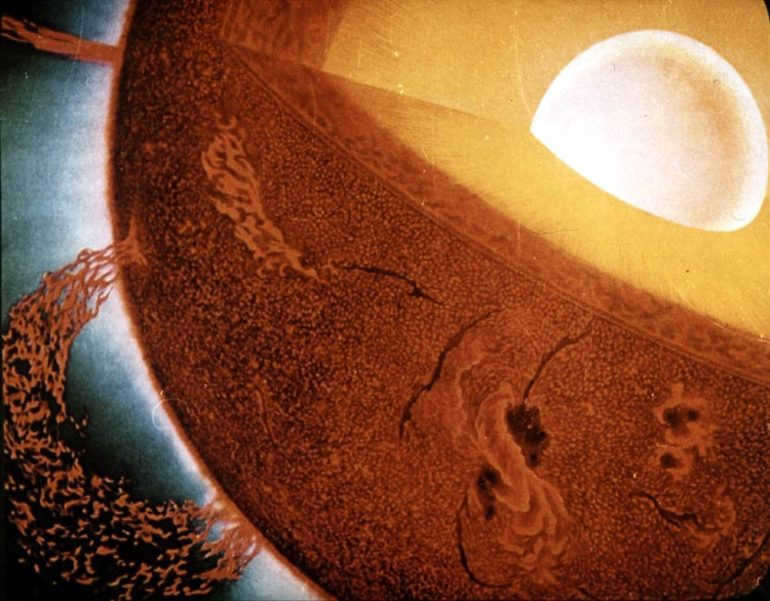
Within the heart of this celestial body, which possesses immense mass and pressure, individual hydrogen atoms undergo fusion and combine to create helium, resulting in the release of extraordinary amounts of energy. The solar core can be likened to a colossal hydrogen bomb.
Attempting to comprehend the continuous detonations of one billion nuclear bombs occurring every single second over the span of four billion years is a daunting task. The astronomical nuclear power contained within the Sun propels hundreds of millions of tons of matter outward, while gravity counters this force and exerts an inward pull. These two opposing forces exist in perfect equilibrium, as any disruption to this balance could potentially have disastrous consequences for our planet.
The enigmatic corona
During a complete solar eclipse, when the moon’s disk obscures the sunlight, the human eye is able to witness the enigmatic solar atmosphere known as the corona. It provides a glimpse into the process by which the star releases electrically charged particles, known as the solar wind.
The corona presents two perplexing enigmas:
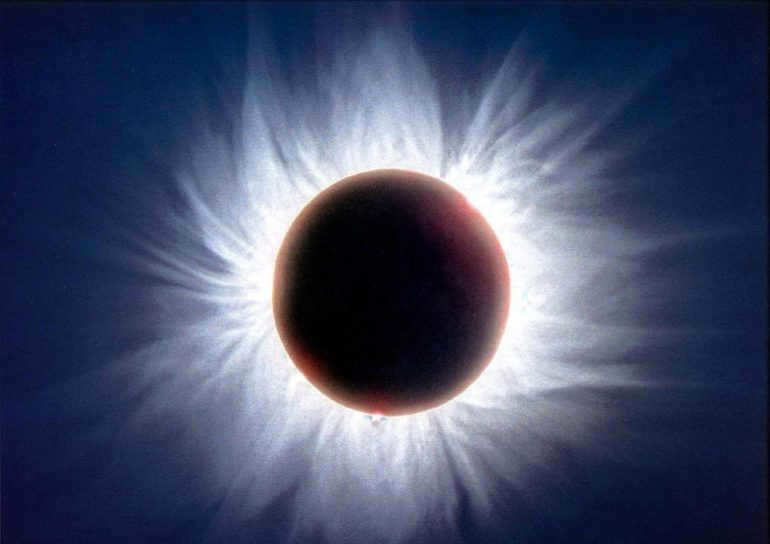
- The temperature of the corona is several million degrees Celsius, making it hotter than the surface of the Sun, which is about 6,000 degrees Celsius.
- Within the corona, matter undergoes sudden acceleration, resulting in the formation of a solar wind composed of a magnetic field, protons, and electrons. This solar wind permeates throughout the entire planetary system and any changes in its speed and intensity can have significant impacts on Earth’s inhabitants.
As of now, these enigmas continue to puzzle investigators. There are plans to launch a solar probe in the near future. This specially engineered device, equipped with safeguards against extreme temperatures and solar radiation, will venture as close as possible to the Sun. The probe will complete seven orbits around the star before ultimately incinerating. Through this mission, scientists anticipate uncovering the mysteries of the solar corona.
The process of life
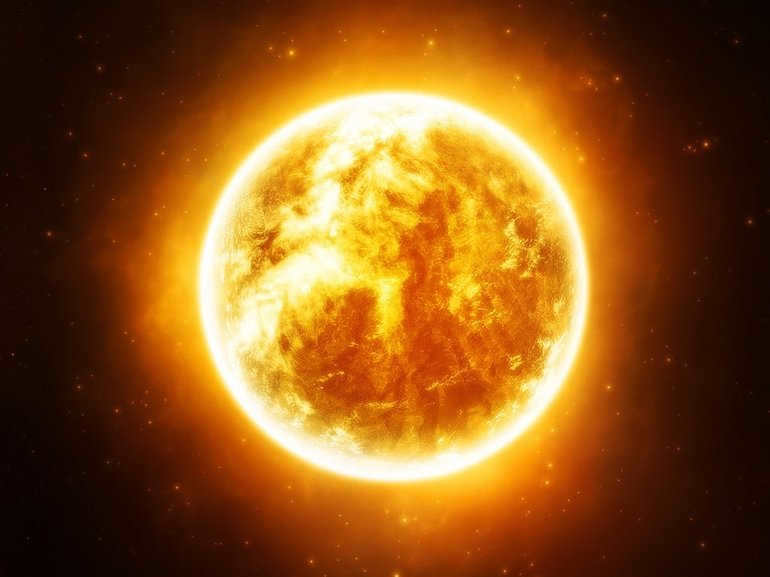
At present, the Sun is in its prime. It is classified as a yellow dwarf star. It possesses enough hydrogen to sustain its combustion for approximately 5 billion more years. Once the hydrogen supply is depleted, the pressure within the core will decrease. Consequently, the star’s core will weaken, causing its outer layers to expand significantly. This expansion will result in the Sun becoming a red giant. Following this transformation, the Sun will grow to be 200 times larger than it currently is and a thousand times brighter. It will consume the neighboring planets.
Over time, the Sun will cool down, contract, and transform into a white dwarf, gradually fading away over billions of years.
The group of inner planets consists of four celestial bodies: Mercury, Venus, Earth, and Mars. These planets are situated relatively close to the Sun, which is why they are also referred to as the inner planets.
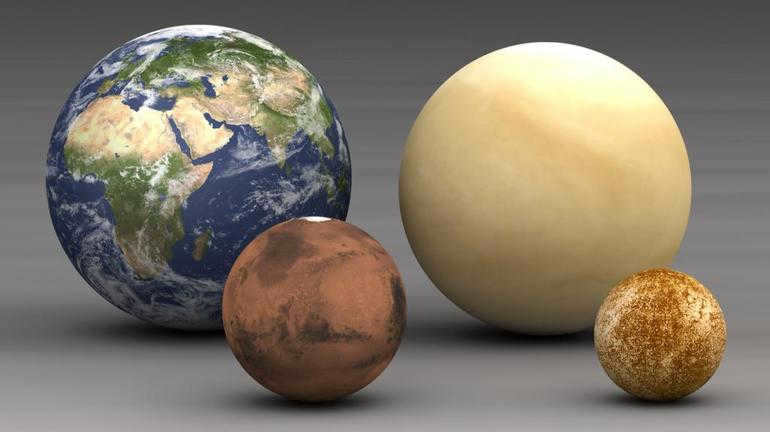
Main features:
- Relatively petite size and weight.
- Firm surface.
- Dense matter.
- Comparable chemical makeup (metal and minerals).
- Existence of an atmosphere.
- Comparable inner structure.
- Scarcely any satellites.
- Faint magnetic field.
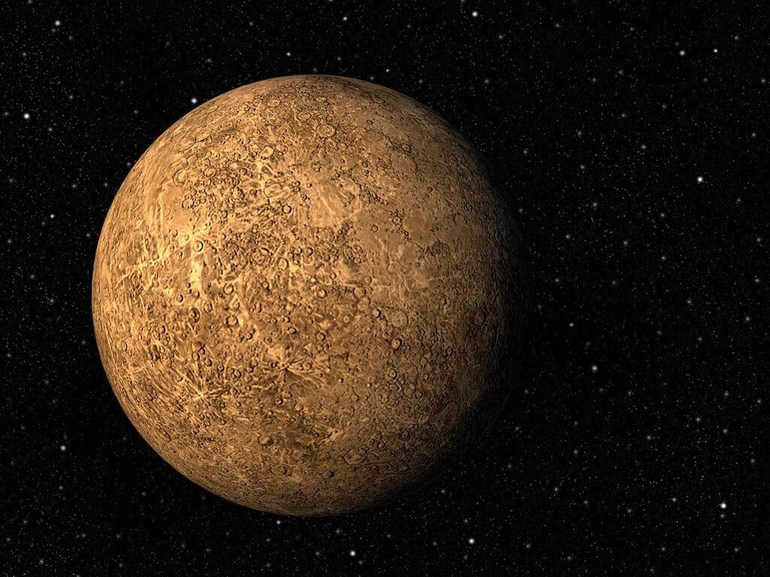
The inner planets have a core made of hot molten iron with a small amount of other metals. Surrounding the core is a mantle composed of silicates. The outermost layer, known as the crust, is formed by a combination of internal heat and external factors.
The surface temperature of the inner planets varies greatly due to differences in solar energy received. Additionally, the atmospheres of Mars, Venus, and Mercury contain little to no oxygen, and the pressure and gravity on these planets are significantly different from those on Earth. Human habitation on their surfaces is only possible with the use of a space suit. Despite these similarities, no signs of life have been discovered on these three planets.
Although there are many similarities, the physical conditions on each of the four planets are incredibly distinct:

- Mercury, the tiniest planet in our solar system, is located approximately 58 million kilometers from the Sun, which is three times closer than Earth. Due to its extremely rarefied atmosphere, the surface temperature experiences drastic fluctuations, ranging from -173 to +426 degrees Celsius. Mercury completes one revolution around the Sun every 88 Earth days and rotates on its own axis every 176 Earth days. Interestingly, a day on Mercury is twice as long as a year. Additionally, this planet does not possess any natural satellites.
- The Earth is situated about 150 million kilometers away from the Sun, making it a prime location for a diverse range of life forms to thrive. With two-thirds of its surface covered in vast oceans and polar regions adorned with glaciers, the planet offers a unique blend of habitats. The atmosphere is predominantly composed of nitrogen and oxygen, resulting in temperature variations that can range from a chilling -90 degrees Celsius to a scorching +57 degrees Celsius.
- Mars is situated approximately 228 million kilometers away from the Sun. This celestial body, also known as the Red Planet, is half the size of our home planet and boasts a unique atmosphere composed primarily of carbon dioxide, with traces of nitrogen and argon. Surprisingly, the oxygen content on Mars is rather low, not exceeding a mere 0.13%. When it comes to its surface, it is adorned with a plethora of craters, valleys, volcanoes, and mountain ranges. One of the most remarkable features on Mars is Mount Olympus, the tallest mountain in the entire solar system, reaching a staggering height of 22,446 meters. In terms of mass, Mars is approximately one-tenth of Earth’s weight. The Martian year lasts for 687 Earth days, while a day on Mars lasts for precisely 24 hours and 37 minutes. As far as temperatures are concerned, they can fluctuate dramatically, ranging from a chilling -170 degrees Celsius to a scorching +120 degrees Celsius.

The Solar System is a collection of celestial bodies that orbit around a central star, known as the Sun. Over the years, scientists have dedicated their efforts to studying and understanding the structure of our Milky Way galaxy, with a particular focus on our own solar system. However, with advancements in astronomical research and the discovery of new types of stars like pulsars, as well as exoplanets, this traditional view has been challenged and revised.
Overview
The enigmas of our Solar System
Our Solar System is a fascinating collection of celestial bodies held together by gravity. It is composed of a colossal central body known as the Sun, eight immense planets accompanied by over 100 satellites, as well as the asteroid belt and the Kuiper belt. The Kuiper belt is made up of meteoric matter, dust, and comets and was first discovered between the years 1992 and 2000 at a distance of 30-50 astronomical units from the Sun. It is home to approximately 70-100 thousand objects with a diameter of about 100 kilometers. One of the most notable members of the Kuiper belt is Pluto, which was reclassified as a dwarf planet during the 26th General Assembly of the International Astronomical Union in 2006.
According to contemporary theories, the formation of the Sun and the solar system occurred approximately 46 trillion years ago through the gravitational collapse of a cloud of interstellar gas and dust.
The majority of the mass within the Sun’s gravitational pull is concentrated in eight planets that have nearly circular orbits and are situated within a flat disk known as the ecliptic plane. These planets, which include Mercury, Venus, Earth, and Mars, are often referred to as the terrestrial planets and are primarily composed of silicates and metals. In contrast, the outer planets, namely Jupiter, Saturn, Uranus, and Neptune, are classified as gas giants and are predominantly composed of hydrogen and helium. These gas giants are significantly more massive than the terrestrial planets.
There are two regions in our solar system that contain numerous small objects. The first one, known as the asteroid belt, can be found between the orbits of Mars and Jupiter. Its composition is similar to that of the Earth-group planets, primarily consisting of silicates and metals. The largest bodies within the asteroid belt include Ceres, Pallada, and Vesta. Moving further out from Neptune’s orbit, we encounter trans-Neptunian objects which are composed of frozen water, ammonia, and methane. The most notable members of this group are Pluto, Sedna, Haumea, Makemake, and Erida. Alongside these two sections, there are also other populations of small objects such as comets, meteoroids, and cosmic dust that orbit the Sun.
In addition to the aforementioned small bodies, six of the eight planets in our solar system, as well as three dwarf planets, have natural satellites. Furthermore, each of the outer planets is encircled by rings made up of dust and other particles.
The flow of plasma from the Sun, known as the solar wind, creates a bubble within the interstellar medium known as the heliosphere. This heliosphere extends all the way to the edge of the scattered disk. The hypothetical Oort cloud, which is the source of long-period comets, can reach distances that are about a thousand times greater than the heliosphere.
It’s important to note that the solar system is just a part of the larger Milky Way galaxy.
As the solar system moves through the galaxy, it occasionally encounters interstellar gas-dust clouds. These clouds are highly sparse, so the solar system’s interaction with them only results in a minimal absorption and scattering of solar rays. The impact of this phenomenon on Earth’s history has yet to be determined.
The momentum of the solar system, known as the Momentum of Celestial Motion (MCM), is primarily influenced by the orbits of massive planets such as Jupiter and Saturn, which account for approximately 90% of the total MCM. Surprisingly, the rotational motion of the Sun itself contributes only 2% to the overall MCM, despite the fact that the Sun makes up more than 99.8% of the solar system’s total mass. This unique distribution of the MCM can be attributed to the Sun’s relatively slow rotation and the vast size of the planetary system, which has a cross-section thousands of times larger than the Sun’s diameter. During the formation of the solar system, the planets acquired their share of the MCM, which was transferred to them from the matter that formed their existence.
All the large planets orbit the Sun in the same direction, following the axial rotation of the Sun itself. Their orbits are nearly circular, with a slight inclination to each other and to the plane of the solar equator.
The main plane used for calculating the inclination of planetary and other celestial bodies’ orbits around the Sun is the ecliptic, which is the plane of Earth’s orbit. Distances within the solar system are typically measured in astronomical units, which represent the average distance from Earth to the Sun, approximately 150 million kilometers.
The Sun: A Unique Star
The Sun stands out as the sole star in our solar system and serves as its primary component. With a mass equivalent to 332,900 Earth masses, it possesses the necessary size to sustain thermonuclear fusion reactions within its core. These reactions generate a significant amount of energy, which is then emitted into space in the form of electromagnetic radiation. The Sun’s radiation is most intense within the wavelength range of 400-700 nm.
Based on stellar classification, the Sun falls into the category of a typical G2 main-sequence star. The majority of stars belong to this main sequence, and the Sun occupies a position within it that can be considered somewhat central. While stars that are both bright and hot, like the Sun, are relatively rare, the Milky Way is predominantly populated by dimmer and cooler red dwarf stars, accounting for 85% of all stars in our galaxy.
The position of the Sun on the main sequence indicates that it has not yet depleted its hydrogen supply for nuclear fusion and is approximately halfway through its lifespan. The Sun is currently undergoing a gradual increase in brightness; during its early stages, it was only 70 percent as bright as it is now.
As a type I star, the Sun belongs to the younger stellar population. It formed relatively late in the development of the Universe and is characterized by a higher abundance of heavy elements (referred to as “metals” in astronomy) compared to older type II stars. These heavy elements were created within the cores of earlier stars, so there was limited stellar evolution in the initial generations before the Universe became enriched with these elements.
Younger stars have a higher proportion of metals compared to older stars. Scientists believe that a high level of metallicity was crucial for the formation of our Sun’s planetary system, as planets are created through the accumulation of these “metals”.
Space between planets
Together with light, the Sun gives off an unbroken flow of charged particles (plasma) called the solar wind. This flow of particles travels at a velocity of approximately 1,500,000 kilometers per hour, filling the space near the Sun and creating a sort of planetary atmosphere around it that reaches a distance of at least 100 astronomical units from the Sun. This is referred to as the interplanetary medium. Activities occurring on the surface of the Sun, such as solar flares and coronal mass ejections, disrupt the heliosphere, resulting in space weather. The largest structure within the heliosphere is the Heliospheric Current Layer, which is a spiral surface formed by the impact of the Sun’s rotating magnetic field on the interplanetary medium.
The heliosphere, along with the magnetic fields of the planets, provides partial protection for our solar system against cosmic rays that come from outside our solar system. The density of cosmic rays in the interstellar medium and the strength of the Sun’s magnetic field both fluctuate over time, leading to variations in the level of cosmic radiation within the Solar System. However, the exact extent of these variations is not known.
Within the interplanetary medium, there are two disk-shaped regions where cosmic dust forms. One of these regions is the zodiacal dust cloud, which is found in the inner part of our solar system and produces the zodiacal light. This dust cloud is believed to have originated from collisions within the asteroid belt.
Planets
The planets can be categorized into two groups based on their mass, chemical composition, rotational speed, and number of satellites. The density of the planets is a significant indicator of their chemical composition. The four planets closest to the Sun, known as the Earth-group planets, are relatively small and predominantly consist of dense rocky matter and metals. On the other hand, the giant planets – Jupiter, Saturn, Uranus, and Neptune – are much more massive and primarily composed of lighter matter. Despite the immense pressure in their interiors, these giant planets have low density. Hydrogen and helium make up the majority of Jupiter and Saturn’s mass, with up to 20% consisting of stony substances and light compounds of oxygen, carbon, and nitrogen that condense at low temperatures. In the case of Uranus and Neptune, ice and rocky matter account for a slightly larger fraction of their overall mass.
The arrangement of the planets around the Sun follows a predictable pattern – as the distance from the Sun increases, so does the gap between each orbit. These consistent patterns of planetary motion, along with the division of the planets into two groups based on their physical properties, suggest that the Solar System was not formed randomly but rather through a unified process. By studying each celestial body within the solar system, we can gain insight into the origins of the entire system, as well as the evolution and current structure of our own planet Earth.
Thanks to the nearly circular shape of the planetary orbits and the considerable distances between them, close encounters between planets that could significantly alter their trajectories due to mutual gravitational attraction are highly unlikely. This ensures the long-term stability and endurance of the solar system.
The planets all have the ability to rotate on their own axes, with the exception of Venus and Uranus. In most cases, the rotation is in the same direction as their orbits around the Sun, which is known as direct rotation. However, Venus has an extremely slow rotation that goes in the opposite direction, while Uranus rotates on its side.
Furthermore, Saturn, Jupiter, and Uranus have a collection of small satellites that form rings, in addition to their larger satellites. These smaller satellites orbit so closely to their respective planets that the tidal forces prevent them from merging into a single body.
The region closest to the Sun in our solar system
This region, known as the inner region, consists of the Earth-group planets and asteroids. These celestial bodies are primarily made up of silicates and metals. While relatively small in size, this region is still significant – its radius is smaller than the distance between the orbits of Jupiter and Saturn.
Planets of the Earth-group
The four inner planets, which belong to the Earth-group, are predominantly composed of heavy elements. Unlike the outer planets, they have few satellites and lack rings. These planets are mainly made up of refractory minerals like silicates, which form their mantle and crust, as well as metals such as iron and nickel, which make up their core. Additionally, Venus, Earth, and Mars have atmospheres, and all four planets exhibit impact craters and tectonic surface features, including rift depressions and volcanoes. [3] [4] [5]
Mercury (0.4 astronomical units from the Sun) is the nearest planet to the Sun and the tiniest planet in the system (0.055 times the mass of Earth). Mercury does not have any moons, and its only identified geological characteristics, aside from impact craters, are countless jagged inclines extending for hundreds of kilometers – escarpments, which likely formed due to tidal distortions during an early stage in the planet’s history when its axial rotation period differed from its orbital rotation period around the Sun.
Mercury possesses an exceedingly uncommon atmosphere. It is comprised of atoms that have been “carried away” from the surface of the planet by the solar wind. The origins of the substantial iron core of Mercury and its delicate crust have yet to be satisfactorily accounted for. One hypothesis proposes that the outer layers of the planet, composed of lighter elements, were stripped away due to a colossal collision, resulting in a reduction in the planet’s size and preventing Mercury from being fully assimilated by the youthful Sun.
Venus
Venus, which has a mass of 0.815 times that of Earth, is a planet similar in size to Earth. Like our planet, Venus also has a robust atmosphere and a thick silicate shell surrounding an iron core. There are indications of internal geologic activity on Venus as well. However, Venus possesses much less water compared to Earth, and its atmosphere is ninety times denser. Unlike Earth, Venus has no moons. It holds the title for being the hottest planet, with a scorching surface temperature exceeding 400°C. This extreme heat is the result of the greenhouse effect caused by its dense atmosphere rich in carbon dioxide. While no definitive evidence of geologic activity has been discovered on Venus, the absence of a magnetic field suggests that volcanic eruptions regularly replenish its atmosphere.
Planet Earth
Planet Earth, the largest and most dense of the inner planets, possesses a distinctive feature in the form of its natural satellite, the Moon. Among the Earth-group planets, Earth stands out due to its unique hydrosphere. Furthermore, Earth’s atmosphere sets it apart from other planets as it contains an abundant amount of free oxygen. While the possibility of life existing beyond Earth remains a mystery, the question continues to intrigue scientists and researchers.
Mars is smaller than Earth and Venus, weighing only 0.107 times the mass of Earth. Its atmosphere consists mostly of carbon dioxide, with a surface pressure of 6.1 mbar, which is only 0.6% of Earth’s atmosphere. The planet is home to volcanoes, with the largest one named Olympus, surpassing the size of all terrestrial volcanoes. Olympus stands at an impressive height of 21.2 km. Evidence of past tectonic activity can be seen in the form of rift depressions, such as Mariner Valley, along with the presence of volcanoes. According to modern data, this tectonic activity ceased approximately 2 million years ago. The red hue of Mars’ surface is a result of the high concentration of iron oxide in its soil. Additionally, Mars has two moons, Phobos and Deimos, which are thought to be asteroids that were captured by the planet.
The region between Mars and Jupiter filled with asteroids is known as the asteroid belt
Asteroids are the most prevalent small objects in the solar system. Positioned between the orbits of Mars and Jupiter, around 2.3 to 3.3 a.u. from the Sun, lies the asteroid belt. These bodies are thought to be leftover remnants from the early formation of the solar system, unable to merge into a single entity due to the gravitational influences of Jupiter.
Asteroids come in a range of sizes, from just a few meters to hundreds of kilometers in diameter. While they are primarily categorized as small bodies within the solar system, certain ones, like Vesta and Hygeia, may be reclassified as dwarf planets if they are found to have achieved hydrostatic equilibrium.
The asteroid belt is home to a vast number of objects, potentially numbering in the millions, that are larger than one kilometer in size. However, despite the large quantity, the combined mass of these asteroids is only a fraction of the Earth’s mass. Objects in the range of 100 microns to 10 meters in diameter are referred to as meteoroids.
These celestial bodies in our solar system are quite sizable. They are so massive that their own gravitational forces have shaped them into nearly spherical forms. However, unlike planets, their mass is not sufficient to “clear” their orbital paths of other similar bodies. [10] The International Astronomical Union officially defined dwarf planets at its 2006 general assembly. In accordance with this resolution,[11] Pluto was reclassified from a major planet to a dwarf planet (joining Ceres, Erid, Makemake, and Haumea) and leaving only eight major planets in our solar system.
Asteroids
The majority of the known minor planets’ orbits are situated between Mars and Jupiter, forming what is commonly referred to as the main asteroid belt. While most of these objects orbit the Sun in the same direction as the larger planets, their orbits are typically elongated and inclined relative to the ecliptic plane.
The interiors of planets and some large satellites, like the Moon, exist in a molten state. In the Earth group of planets and satellites, the low thermal conductivity of their outer layers results in minimal heat release, with the contribution to surface temperature comparable to the heat received from the Sun. Conversely, the convection within giant planets leads to a significant flow of heat from their interiors, even surpassing the heat they receive from the Sun.
The atmospheres of Venus, Earth, and Mars consist of gases that are emitted from within these planets. In contrast, the giant planets do not have a solid or liquid surface and their atmospheres are a direct continuation of their interior. As the gases descend towards the center, they gradually transition into a condensed state.
Comets
Comets primarily travel in elongated orbits that are close to parabolic orbits. Some comets have elongated orbits that are relatively small in size, ranging from tens to hundreds of astronomical units. These comets, known as periodic comets, mainly move in a direct motion, meaning their rotation occurs in the same direction as the planets.
The nuclei of comets are composed of water ice, various gases, and a mixture of stony substances. This elemental and chemical composition of the nuclei is similar to that of the giant planets. Most small planets have compositions similar to the stony planets in the Earth group. However, Chiron, a recently discovered celestial body that moves between the orbits of Saturn and Uranus, is likely similar to the icy nuclei of comets and small satellites of planets located far from the Sun.
The dynamics and physical characteristics of the Solar System’s structure suggest that the planets originated from a protoplanetary cloud composed of gas and dust surrounding the Sun. The terrestrial planets formed through the accumulation of solid rocky particles, whereas the giant planets initially formed through the aggregation of rocky-ice particles, which were later supplemented by the addition of gases, primarily hydrogen and helium, during their growth.
Distant regions
The precise demarcation of the boundary between the solar system and interstellar space remains elusive. Two factors are deemed particularly influential: the solar wind and solar gravity. The heliopause, where the hydrodynamic pressure of the solar plasma is counterbalanced by the interstellar plasma, serves as the outer limit of the solar wind. Within this boundary, the solar magnetic field displaces the galactic field. [12] The heliopause is situated approximately 100 astronomical units away. However, it is hypothesized that the point at which the Sun’s gravitational pull becomes dominant (known as Hill’s sphere) is almost a thousand times farther.
Original Notes
- ↑Lundin. Erosion by the Solar Wind
- ↑Schrijver, CJ and Zwaan, C. (2000). Solar and Stellar Magnetic Activity. Cambridge Astrophysics Series. Cambridge University Press.
- ↑[1]
- ↑[2]
- ↑[3]
- ↑[4]
- ↑[5]
- ↑[6]
- ↑[7]
- ↑Dwarf planets. Main Astronomical Observatory of the National Academy of Sciences of Ukraine.
- ↑Definition Of A Planet In The Solar System. International Astronomical Union
- ↑ Heliosphere // Astronomical Encyclopedic Dictionary / Under the general editorship of I. A. Klimishin and A. A. Korsun. – Lvov: LNU-GAO NASU, 2003. – С. 104-105
Rephrased Notes
- ↑Lundin. The Solar Wind’s Erosion
- ↑Schrijver, CJ and Zwaan, C. (2000). Solar and Stellar Magnetic Activity. Cambridge Astrophysics Series. Cambridge University Press.
- ↑[1]
- ↑[2]
- ↑[3]
- ↑[4]
- ↑[5]
- ↑[6]
- ↑[7]
- ↑Dwarf planets. Main Astronomical Observatory of the National Academy of Sciences of Ukraine.
- ↑Definition Of A Planet In The Solar System. International Astronomical Union
- ↑ Heliosphere // Astronomical Encyclopedic Dictionary / Under the general editorship of I. A. Klimishin and A. A. Korsun. – Lvov: LNU-GAO NASU, 2003. – С. 104-105
Literature
- Pat Dasch: Icy worlds of the solar system. Cambridge University Press, Cambridge 2004, ISBN 0-521-64048-2.
- Joachim Gürtler, Johann Dorschner: The Solar System. Scientific Writings on Astronomy. Barth, Leipzig / Berlin / Heidelberg 1993, ISBN 3-335-00281-4
- CH Heller: Encounters with protostellar disks. I – Disk tilt and the nonzero solar obliquity, ApJ 408, 1993, p. 337.
- Pavel Kroupa: The dynamical properties of stellar systems in the Galactic disk, MNRAS 277, 1995, p. 1507 (PDF at ArXiv).
- Glenn J. MacPherson: Oxygen in the solar system. Mineralogical Society of America, Chantilly 2008, ISBN 978-0-939950-80-5
- Eugene F. Milone, William J. Wilson: Solar system astrophysics. Springer, New York 2008, ISBN 978-0-387-73153-7
- Polarimetric remote sensing of Solar System objects / Mishchenko MI [ao] = Remote sensing of solar system objects by polarimetric means / M. I. Mishchenko [et al]. – Kyiv: Akademperiodyka, 2010. – 292 p. : Fig., Tab. ; 12 l. : Pl. – (Projekt “Ukrainian scientific book in a foreign language”). – Bibliography: pp. 244-277.
- A new hypothesis has been proposed by Voytovich, Vladimir Kondratyevich regarding the formation and development of the Solar System – L.: Lviv Polytechnic, 1995. – 40 с
- The use of CCD methods for studying the bodies of the Solar System has been explored under the guidance of G. I. Pinigin at the Nikolaev Astronomical Observatory. – Nikolaev: Atoll, 2000. – 112 p.: ill.
- G. H. Polishchuk has written a book on the beginnings of the Solar System. – M.: Kyiv-Mohyla Academy, 2006. – 20 с.
A unique model of our solar system is depicted here, complete with asteroids from the main belt (which lies between the orbits of Mars and Jupiter) and the Kuiper belt (which extends beyond the orbit of Neptune). In addition, three trans-Neptunian objects – Erida, Makemake, and Haumea – are included. The diameters of the planets are represented in a notional manner. The first 30 asteroids from the main belt, as well as Chiron (2060), are inscribed on this model.
SOLAR
– The Sun, our solar system’s only star, is a yellow dwarf. It accounts for a staggering 99.86% of the entire mass of the solar system. To give you an idea of its size, more than a million Earths could fit inside the Sun. Interestingly, the Sun is almost a perfect sphere, with a difference of only 10 kilometers between its polar and equatorial diameters. It takes approximately 8 minutes for the Sun’s light to reach the Earth.
Physical characteristics. The radius of the Sun is 695,000 kilometers, and its mass is 1.99e30 kilograms. The density of the Sun is 1.41 g/cm3. It has a stellar magnitude of -26.0 and an absolute stellar magnitude of 4.71. The Sun has a rotation period of 24.6 days around its axis and a liberation velocity of 580 km/s. It belongs to the spectral class G. The inclination of the Sun’s equator to the ecliptic is 7°15′. The Sun is primarily composed of H2 and He.
MERCURY
– is the planet closest to the Sun. It lacks an atmosphere, allowing for direct observation of its surface. The temperature on Mercury ranges from 426°C on the Sun-facing side to -173°C on the night side.
Orbit information. Mercury has an average distance of 57,910,000 km from the Sun and an orbital period of 87.97 days. Its inclination to the ecliptic is 7.00°, and it has an eccentricity of 0.21. The synodic period of rotation for Mercury is 115.8775 days.
Additional details. The force of gravity on VENERA is equivalent to 0.378 times the force of gravity on Earth. The velocity at which objects are released from the surface is 4.25 kilometers per second. The average velocity of objects in orbit around VENERA is 47.87 kilometers per second. The equator of VENERA is not inclined with respect to its orbit. The longitude of the point where VENERA’s orbit crosses the ecliptic is 48.35 degrees. The longitude of the point where VENERA is closest to the Sun is 77.44 degrees. The surface temperature on VENERA is 440 Kelvin. The pressure on VENERA is 0 atmospheres. The magnetic field strength on VENERA ranges from 2e-3 to 1e-2 Gauss. The solar energy flux on VENERA is between 4.61 and 10.61 times that of Earth.
VENERA
has a size that is nearly equal to that of Earth. It is the second planet in our solar system, positioned between Mercury and Earth. Similar to Mercury, VENERA cannot be observed at midnight. The atmosphere of VENERA consists of dense clouds made of sulfuric acid. The average temperature on the surface of VENERA is approximately 464 degrees Celsius.
Data related to VENERA’s orbit includes an average distance from the Sun of 108,200,000 kilometers. The time it takes for VENERA to complete one orbit around the Sun is 224.70 days. The inclination of VENERA’s orbit with respect to the ecliptic is 3.39 degrees. The eccentricity of VENERA’s orbit is 0.01. The synodic rotation period of VENERA is 583.9214 days.
Physical characteristics. The equatorial radius of the planet is 6052 km, and its mass is 4.87e24 kg. The density is 5.24 g/cm 3, with an albedo of 0.65. The stellar magnitude is -4.4. The rotation period around its axis is 243 days (retrograde), and the visible diameter is 9.8/66.7 seconds of arc.
Additional information. The gravity on the planet is 0.905 g, and the escape velocity is 10.36 km/s. The average orbital velocity is 35.02 km/s. The inclination of the equator to the orbit is 177.36°, and the longitude of the ascending node is 76.72°. The perihelion longitude is 131.56°. The surface temperature is 730 K, with a pressure of 93 atm. The atmospheric composition primarily consists of CO2 and N2. The planet has a magnetic field of 3 and an albedo of 0.37. The rotation period around its axis is 0.99 days.
Extra details. Gravity force – 1,000 times stronger than on Earth. Initial speed – 11.18 kilometers per second. Average speed in orbit – 29.79 kilometers per second. Inclination from the equator to the orbit – 23.45 degrees. Compression rate – 0.00335. Longitude of the point where the orbit crosses the equator – 354.90 degrees. The longitude of the point where the orbit is closest to the Sun is 102.83 degrees. Surface temperature – 287 Kelvin. Pressure – 1 atmosphere. Atmospheric composition – Nitrogen (N2), Oxygen (O2), Argon (Ar). Magnetic field strength – between 0.3 and 0.6 Gauss.
MOON
– is Earth’s only natural satellite. The Moon always shows the same face to the Earth. The Moon is gradually moving away from the Earth (at a rate of approximately 3.8 centimeters per year).
Physical characteristics. The average distance from Earth is approximately 384,400 km. The average visible size is about 31’5″. The brightness of the full Moon is measured at -12.5 magnitudes. The time it takes for the Moon to complete one orbit around the Earth (sidereal period) is approximately 27.32 days. The time it takes for the Moon to go through its phases (synodic period) is about 29.53 days. The average speed at which the Moon orbits the Earth is 1.02 km/s. The angle between the Moon’s orbit and the ecliptic is 5°09′. The ellipticity of the Moon’s orbit is 0.0549. The diameter of the Moon is 3476 km. The Moon’s mass is approximately 0.0123 times that of Earth. The density of the Moon is about 0.60 times that of Earth. The velocity required to escape the Moon’s gravitational pull is 2.4 km/s.
MARS
– The fourth planet in our solar system, located after Earth’s orbit. As a result, it can be observed throughout the night. The temperature on Mars varies, dropping from around 20 °C during the day at the equator to -85 °C at night.
Data about the orbit. The average distance from the Sun is 227,940,000 km. The orbital period is 686.98 days. The inclination to the ecliptic is 1.85°. The eccentricity is 0.09. The synodic period of rotation is 779.9361 days.
Information about physical characteristics. The equatorial radius is 3397 km. The mass is 6.42e23 kg. The density is 3.93 g/cm 3 . The albedo is 0.15. The stellar magnitude is -2.0. The rotation period around the axis is 1.03 days. The visible diameter is 3.5/25.5 sec of arc.
Further details. Gravitational force – 0.379 g. Launch speed – 5.02 km/s. Mean orbital velocity – 24.13 km/s. The angle of the equator to the orbit is 25.19°. Compression is 0.00519. The longitude of the ascending node is 49.60°. Perihelion longitude – 335.99°. Surface temperature – 218 K. Pressure – 0.007 atm. Atmospheric composition – CO2, N2Ar. Magnetic field – 6e-4 Gs. Solar energy flux (Earth = 1) – 0.43.
JUPITER
– the most massive planet in the solar system and the second brightest object in the sky after the Sun, Moon, and Venus. The atmosphere of Jupiter is entirely composed of gas clouds. The average temperature of the atmosphere of the planet is about -108 °C.
Orbital data. The Sun’s average distance from the Sun is 778,330,000 km. The orbital period of the Sun is 4332.71 days. The inclination of the Sun to the ecliptic is 1.31°. The eccentricity of the Sun is 0.05. The synodic period of rotation for the Sun is 398.884 days.
Physical information. The equatorial radius of the Sun is 71492 km. The mass of the Sun is 1.90e27 kg. The density of the Sun is 1.33 g/cm 3 . The albedo of the Sun is 0.52. The stellar magnitude of the Sun is -2.7. The rotation period around the axis of the Sun is 0.41 days. The visible diameter of the Sun is 31…50 sec of arc.
Additional information. The gravity of the Sun is 2.529 g. The release velocity of the Sun is 59.56 km/s. The average orbital velocity of the Sun is 13.06 km/s. The equator-to-orbit inclination of the Sun is 3.13°. The compression of the Sun is 0.06481. The longitude of the ascending node of the Sun is 100.47°. The longitude of the perihelion of the Sun is 15.63°. The surface temperature of the Sun is 120 K. The atmospheric composition of the Sun is H2, He. The magnetic field of the Sun is 4.3 Gs. The solar energy flux of the Sun (Earth = 1) is 3.7.

SATURN,
similar to Jupiter, is fully covered by clouds. Its most prominent feature is its rings, although they cannot be seen with the naked eye. The average temperature of Saturn’s atmosphere is approximately -139 °C.
Orbital information. Saturn has an average distance of 1,429,400,000 kilometers from the Sun. Its orbital period is 10759.50 days. It has an inclination of 2.49° to the ecliptic and an eccentricity of 0.06. The synodic period of rotation is 378,092 days.
Physical data. Saturn has an equatorial radius of 60268 km and a mass of 5.68e26 kg. Its density is 0.69 g/cm 3 and its albedo is 0.47. The stellar magnitude of Saturn is 0.7. It takes approximately 0.45 days for Saturn to complete one rotation around its axis. The visible diameter of Saturn is 15…21 seconds of arc.
Additional information. Gravity – 1.066 g. Release velocity – 35.49 km/s. Average orbital velocity – 6.80 km/s. Equator-to-orbit inclination – 97.86°. Compression – 0.1076. Longitude of the ascending node – 113.71°. The longitude of the perihelion is 92.80°. The surface temperature is 88 K. Atmospheric composition – H2, He. Magnetic field – 0.21 Gs. Solar energy flux (Earth = 1) – 1.1.
URANUS
is unique in that it has a tilt of 98° compared to its orbit. It has a diameter that is 4 times larger than Earth. The temperature on its surface is -218 °C. Uranus is barely visible to the naked eye.
Orbital data. The average distance from the Sun is 2,870,990,000 kilometers. The orbital period is 30685.00 days. Inclination to the ecliptic, 0.77°. Eccentricity – 0.05. Synodic period of rotation – 369.656 days.
Physical information. Equatorial radius – 25559 km. Mass – 8.68e25 kg. Density – 1.32 g/cm 3 . Albedo – 0.51. Stellar magnitude – 5.5. Rotation period around the axis – 0.72 days (retro). Visible diameter – 3.4…4.1 sec of arc.
NEPTUNE
The discovery of NEPTUNE was made possible by using previously calculated coordinates based on the deviations in the movement of Uranus. When observed from Earth, NEPTUNE appears as a blue disk that moves across the constellations at an average rate of about 2° per year. It is even visible through binoculars.
Orbital data shows that NEPTUNE has an average distance of 4,504,300,000 km from the Sun. Its orbital period is 60190.0 days, and its inclination to the ecliptic is 1.77°. The eccentricity of NEPTUNE’s orbit is 0.01, and it has a synodic period of rotation of 367.487 days.
As for its physical characteristics, NEPTUNE has an equatorial radius of 24766 km and a mass of 1.02e26 kg. Its density is 1.64 g/cm 3 , and its albedo is 0.41. NEPTUNE has a stellar magnitude of 7.8, and it takes approximately 0.67 days for it to complete one rotation around its axis. The visible diameter of NEPTUNE is equivalent to 2.4 seconds of arc.
Additional details. The force of gravity on Pluton is 1.096 times that on Earth. The velocity required to escape its gravitational pull is 23.50 km/s, while the average speed of an object in orbit around Pluton is 5.44 km/s. The angle between Pluton’s equator and the plane of its orbit is 29.60°. The degree of compression of Pluton is 0.026. The longitude of the point where Pluton’s orbit crosses the plane of the ecliptic is 131.81°. The longitude of the point in Pluton’s orbit closest to the Sun is 1.95°. The surface temperature of Pluton is 48 K. The atmosphere of Pluton is composed of hydrogen (H2), helium (He), and methane (CH4). Pluton has a magnetic field ranging from 0.1 to 1 Gs. The amount of solar energy received by Pluton compared to Earth is 0.1.
PLUTON
was designated as a dwarf planet by the International Astronomical Union in 2006.
Orbital information. The average distance between Pluton and the Sun is 5,913,520,000 km. Pluton takes 90800 days to complete one orbit around the Sun. The angle between Pluton’s orbit and the plane of the ecliptic is 17.15°. The eccentricity of Pluton’s orbit is 0.25. The synodic period of rotation for Pluton is 366.74 days.
Physical characteristics. The equatorial radius of the planet is 1137 km, with a mass of 1.27e22 kg. The density is measured at 2.06 g/cm 3 and the albedo is 0.55. It has a stellar magnitude of 13.6 and a rotation period around its axis of 6.39 days (retrograde). The visible diameter is equivalent to 0.2 seconds of arc.
Additional details. The gravity on this planet is only 0.069 times that of Earth’s, with a liberation velocity of 1.22 km/s and an average orbital velocity of 4.74 km/s. The equatorial inclination to its orbit is 122.52°. The longitude of the ascending node is 110.42°, and the longitude of the perihelion is 224.59°. The surface temperature is extremely cold at 37 K, and the atmospheric pressure is very low at 1e-5 atm. The atmospheric composition primarily consists of N2 and trace amounts of CH4CO.
Controls
- Rotation – drag with the left mouse button.
- Offset – drag with the right mouse button.
- Zoom in/out – scroll or drag while holding the middle mouse button.
- Full Screen Mode – F11.
- Increase speed – →.
- Decrease speed – ←.
- Start/Pause – Spacebar.
Configuration
- Velocity – adjust the speed of forward/reverse simulation using the slider.
- Play/Pause – toggle the simulation on/off.
- Asteroids – toggle the display of asteroids on/off.
- Milky Way – toggle the display of the Milky Way image on/off.
- Tracking – choose an object to track.
- Start date – set the initial date of the simulation.
- Screenshot – capture a screenshot (without labels and controls). Right-click on the image opened in a new tab and save it.
Sources
- The HORIZONS system by NASA provides orbital elements of planets.
- The JPL NASA database contains asteroid orbital elements.
- The JPL NASA Small Bodies Database provides orbital elements of transneptunian objects.
- The ESO panorama offers an image of the Milky Way.
- NASA/European Space Agency provides images of the Sun, Moon, and planets.
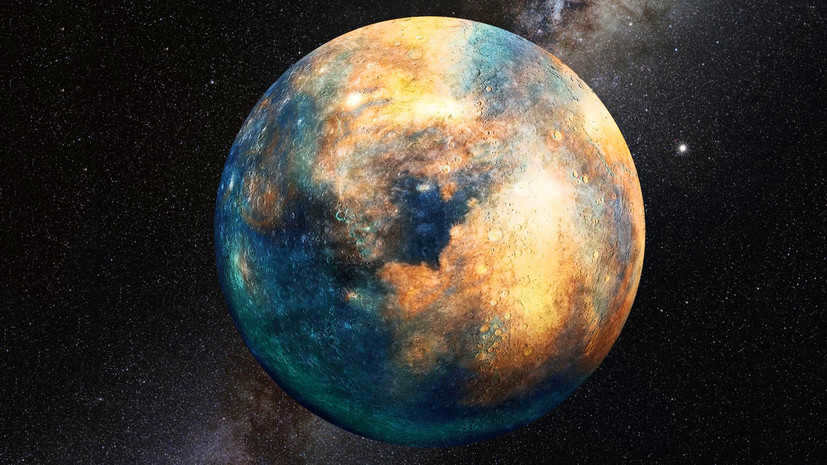
- © Heather Roper/LPL
Planet 10
Astronomers Kat Volk and Rinu Malhotra from the University of Arizona have recently released a study in The Astronomical Journal proposing the existence of a previously unknown planet in the outer region of the Kuiper Belt. This planet is estimated to be about the size of Mars. The researchers reached this conclusion after analyzing the orbital deviations of 600 celestial bodies. The inclination of their orbits differs from that of the known planets in our solar system, suggesting the presence of an unseen celestial body with a gravitational influence on these objects, according to the scientists.
“Based on our calculations, the presence of an undetectable celestial entity seems to be the most reasonable explanation. Our calculations indicate that a celestial body of Mars-like proportions could potentially impact the orbital tilt,” stated the specialists from Arizona.
Volk and Malhotra propose that Planet 10 exists towards the outer boundary of the Kuiper belt, positioned 55 astronomical units away from the Sun. Nevertheless, not all astronomers involved in the hunt for celestial bodies concur with the findings of the University of Arizona scientists. Konstantin Batygin, an astronomer and co-author of the study regarding the hypothetical ninth planet, advises against drawing hasty conclusions.
“According to the expert, the object could potentially lack sufficient mass and may not meet the criteria to be classified as a planet,” the specialist stated.
Batygin also mentioned that the upcoming planetary observations in the Kuiper belt will face challenges in identifying even a Mars-sized object.
Planet 9
Remember the moment when Konstantin Batygin and astrophysicist Michael Brown unveiled their groundbreaking finding? Back in 2016, they revealed that their careful examination of disturbances observed in the far reaches of our solar system led them straight to the existence of Planet 9.
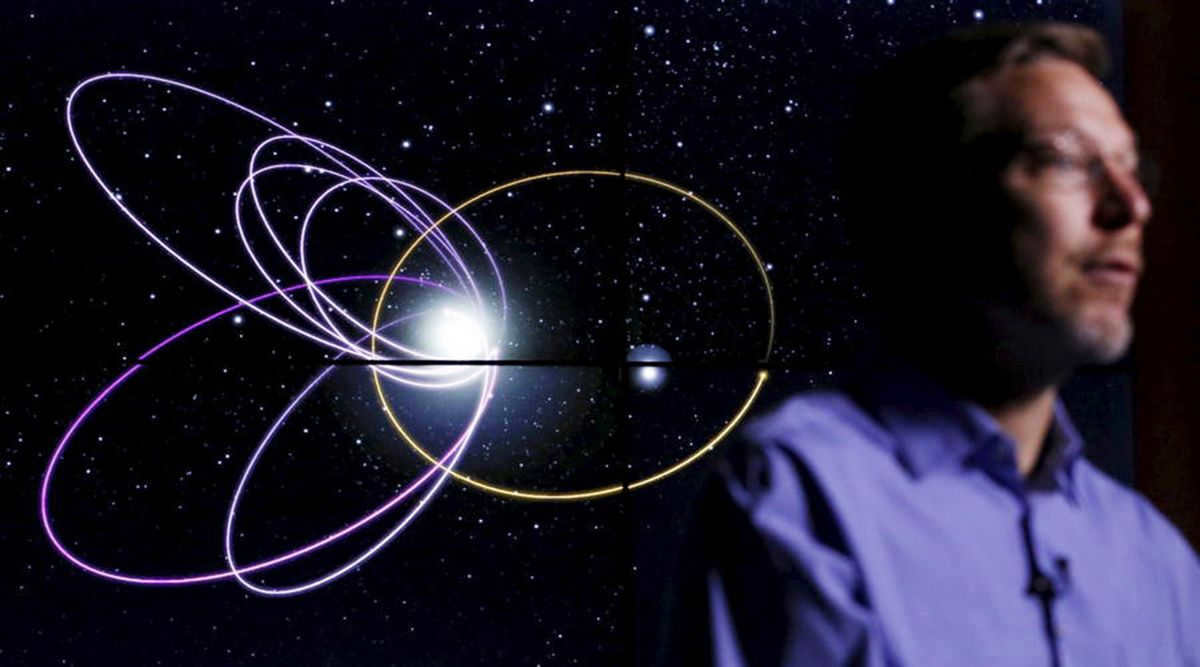
- Reuters
The mass of the hypothetical ninth planet proposed by Batygin and Braun is equivalent to ten times the mass of Earth, in contrast to the relatively small size of Planet 10.
Based on the theory proposed by Brown and Batygin, it is believed that this planet could have originated within our solar system and then been pushed into a more distant orbit by the gravitational forces of either Jupiter or Saturn.
According to the calculations made by the authors of the research, the hypothetical ninth planet is estimated to have a maximum distance from the Sun that is 1000 times greater than that of Earth. Even at its closest point, the distance is at least 200 times greater than the average distance from Earth to the Sun. Furthermore, Planet 9 completes one revolution around the star within a span of 10-20 thousand years.
It should be noted that there are several scientists who have doubts about the idea that there is another planet in our solar system. However, Batygin remains confident in its existence.
“The numerous puzzles in the solar system that seem unrelated can all be explained by the presence of a ninth planet. This cannot be a mere coincidence,” he asserts.
Planet X
Originally, the concept of undiscovered planets within our solar system did not arise as a scientific hypothesis, but rather as a quasi-scientific legend. Starting in the mid-20th century, proponents of alternative theories have discussed Nibiru – a purported planet said to be located between Mars and Jupiter.
Immanuel Velikovsky, a Russian-born American psychiatrist, was the one who sparked the legend of the foreboding planet. In his writings, he theorized that numerous momentous events in ancient history, including those mentioned in the Bible, occurred amidst planetary cataclysms within our solar system and were caused by them. According to Velikovsky, planets altered their orbits and even collided in plain sight of ancient civilizations. He further claimed that the planet Tiamat, also known as Phaeton, was obliterated by an unidentified celestial body passing through the solar system, resulting in the creation of the asteroid belt encircling Mars.

- Velikovsky faced a mental crisis due to the animosity of the scientific community, but he persevered and continued to refine his ideas.
In the United States, the books by the psychiatrist sparked significant public outrage, leading to the emergence of a unique event known as the Velikovsky Affair.
Nonetheless, the pursuit of the enigmatic Planet X was greatly influenced by the writings of American author Zecharia Sitchin, who took it upon himself to decipher Sumerian clay tablets. In doing so, he uncovered key details that previous researchers had overlooked regarding the Sumerians’ astronomical knowledge. Sitchin asserted that the Sumerians possessed knowledge of a “wandering planet” known as Nibiru, which they regarded as a tangible celestial entity. Taking it a step further, he claimed that Nibiru is not only inhabited, but also by a civilization known as the Annunaki. These mysterious beings are believed to be the creators of humanity, having engineered homo sapiens for the purpose of labor in the gold mines of Mesopotamia and Africa.
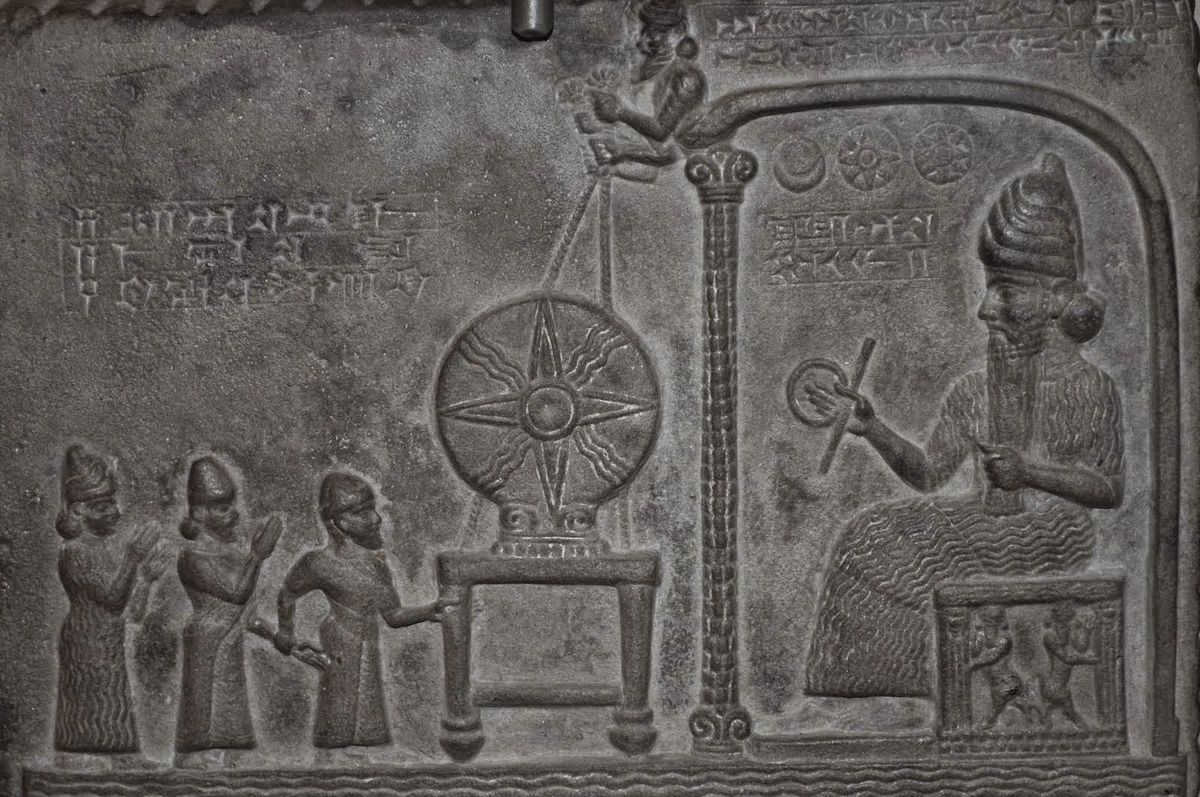
Although his translations are not widely accepted in the scientific community, Zecharia Sitchin’s works have gained popularity among a diverse audience due to their captivating narratives and mysterious content. Notable scholars, such as William Irwin Thompson from the Massachusetts Institute of Technology and York University, as well as Roger Wescott from Drew University, have criticized Sitchin’s work. Michael Heizer, an expert in ancient languages, has accused Sitchin of taking words out of context and distorting their meaning.





